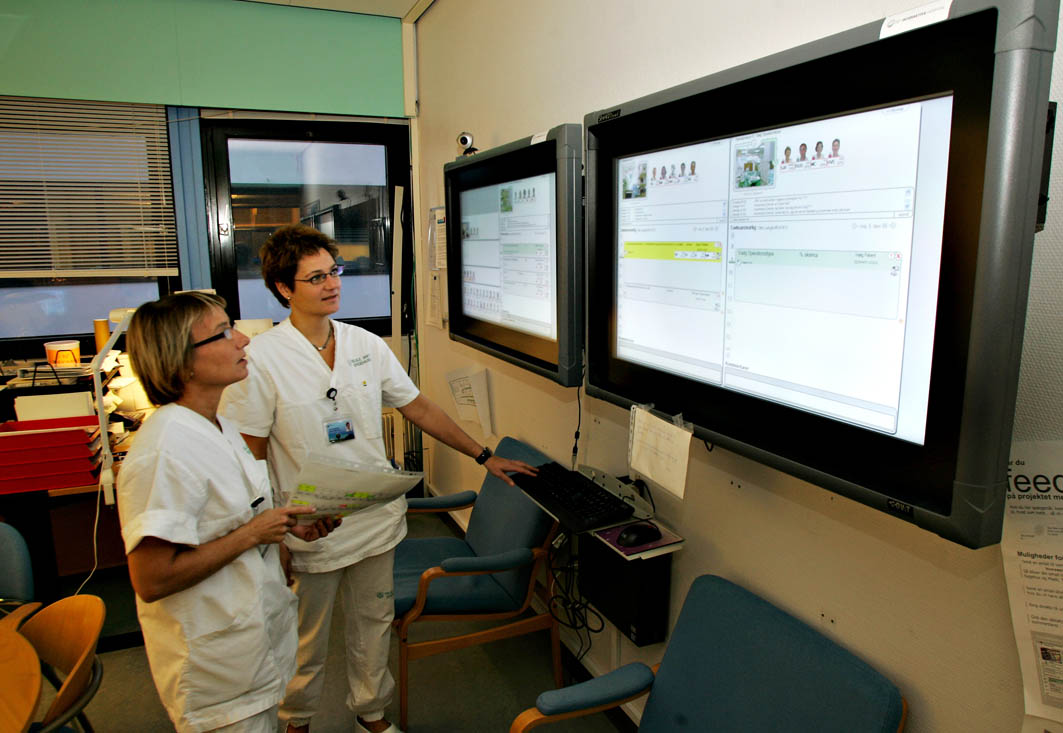The AWARE architecture was built as part of the AWARE project. The architecture was a general-purpose architecture for maintaining ‘context-based social awareness’ within a workplace [1]. It was designed to support the safety- and time-critical work on a surgical department and supported two proof-of-concept end-user applications; the AwarePhone and AwareMedia systems [2, 3].
AWARE Architecture
Maintaining social awareness of the working context of fellow co-workers is crucial to successful cooperation. For mobile, non co-located workers, however, this social awareness is, however, hard to maintain.
Based on extensive studies of medical work in hospitals in general, and in surgical departments in particular, we designed the AWARE architecture, which is a generic platform for supporting context-mediated social awareness in safety- and time-critial work in a mobile work setting [4].
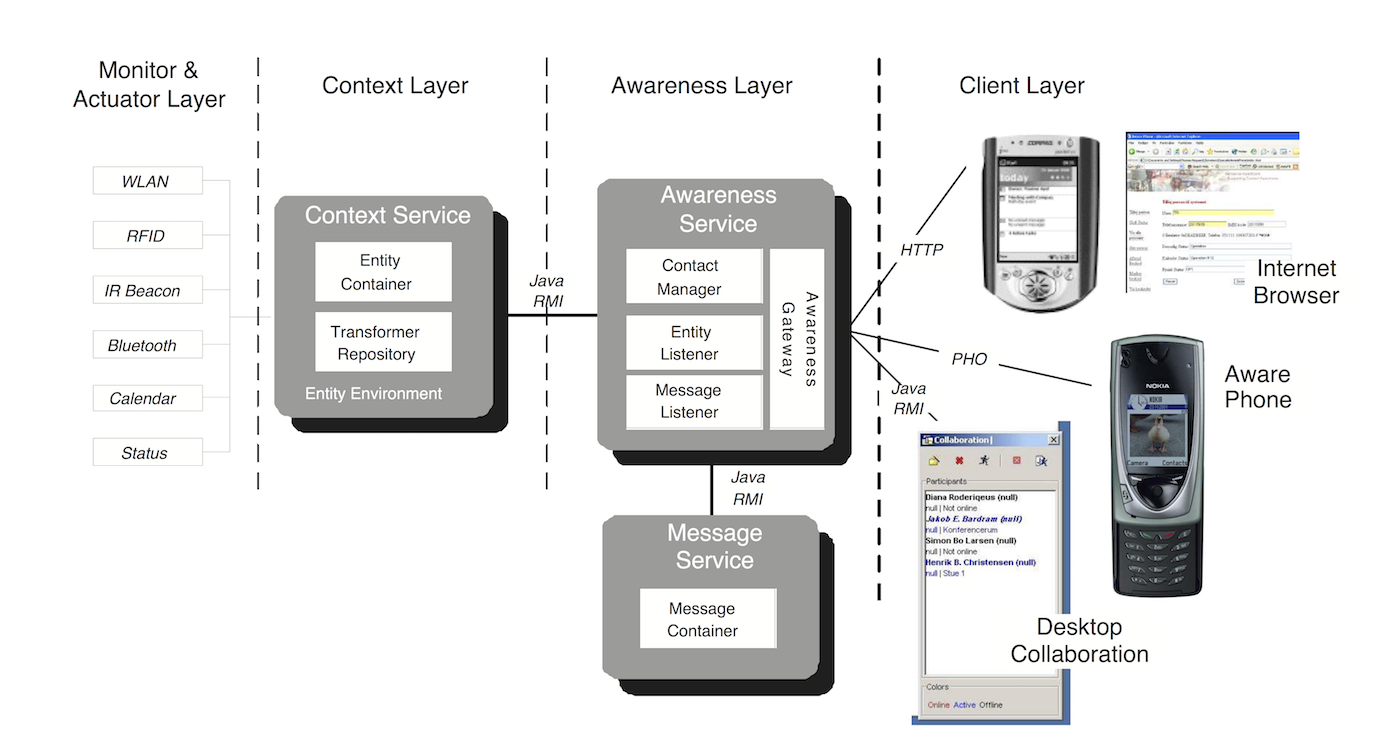
An important part of the AWARE architecture is the ‘context layer’, which is responsible for monitoring context cues in the users’ environment, including displaying cues from users, and for storing, managing, and distributing these cues in the awareness service. The context infrastructure builds on top of the Java Context-Awareness Framework (JCAF) [5].
AwarePhone
The AwarePhone was designed in close collaboration with a set of clinicians who were interested in using (at that time) modern smartphones for communication and coordination inside a hospital. The final design of the AwarePhone supported:
- A contact list with context information. The core context information collected and used are:
- location – the physical location of the clinician, as collected by a bluetooth-based indoor location tracking system
- activity – the current planned activity of the clinicians, such a surgery or outpatient consultation as planned in the hospital planning system
- status – a personal status that a clinician can specify such as ‘operating’, ‘coffee break’, or ‘busy’
- A messaging system with priority marking according to clinical standards, such as ‘actute’
- Voice communication by integrating the contact list to the smartphone’s telephony system.
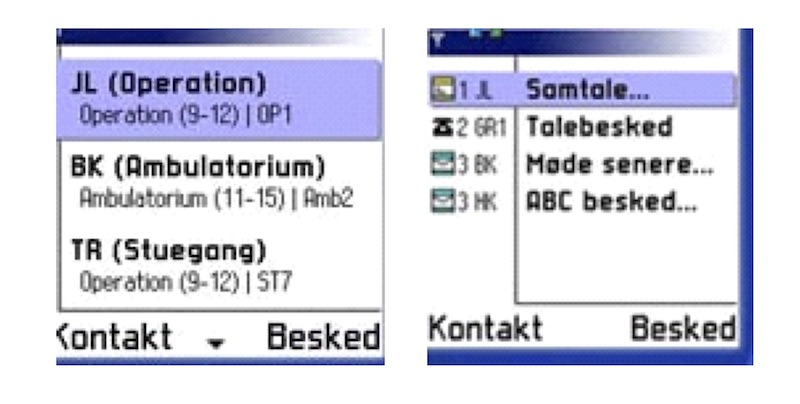
The User Interface of the AwarePhone. Left: The contact list with three users listed. For each user the following context information is shown: initials (e.g., JL), status (e.g., ‘Operation’), activity (e.g., ‘Operation (9-12)’, and location (e.g., ‘OP1’) Right: The message list with one voice message (‘Talebesked’ in Danish) and three text messages with a subject line.
AwareMedia
The scheduling and coordination of surgeries at an operation ward is a particularly challenging task at any modern hospital. Performing surgery is a highly specialized and advanced procedure that involves surgeons, nurses, anesthesiologists, a patient, an operating room, and various equipment. This means that all the people involved in surgical procedures must coordinate their work and constantly maintain an awareness about the ongoing flow of work in the involved wards.
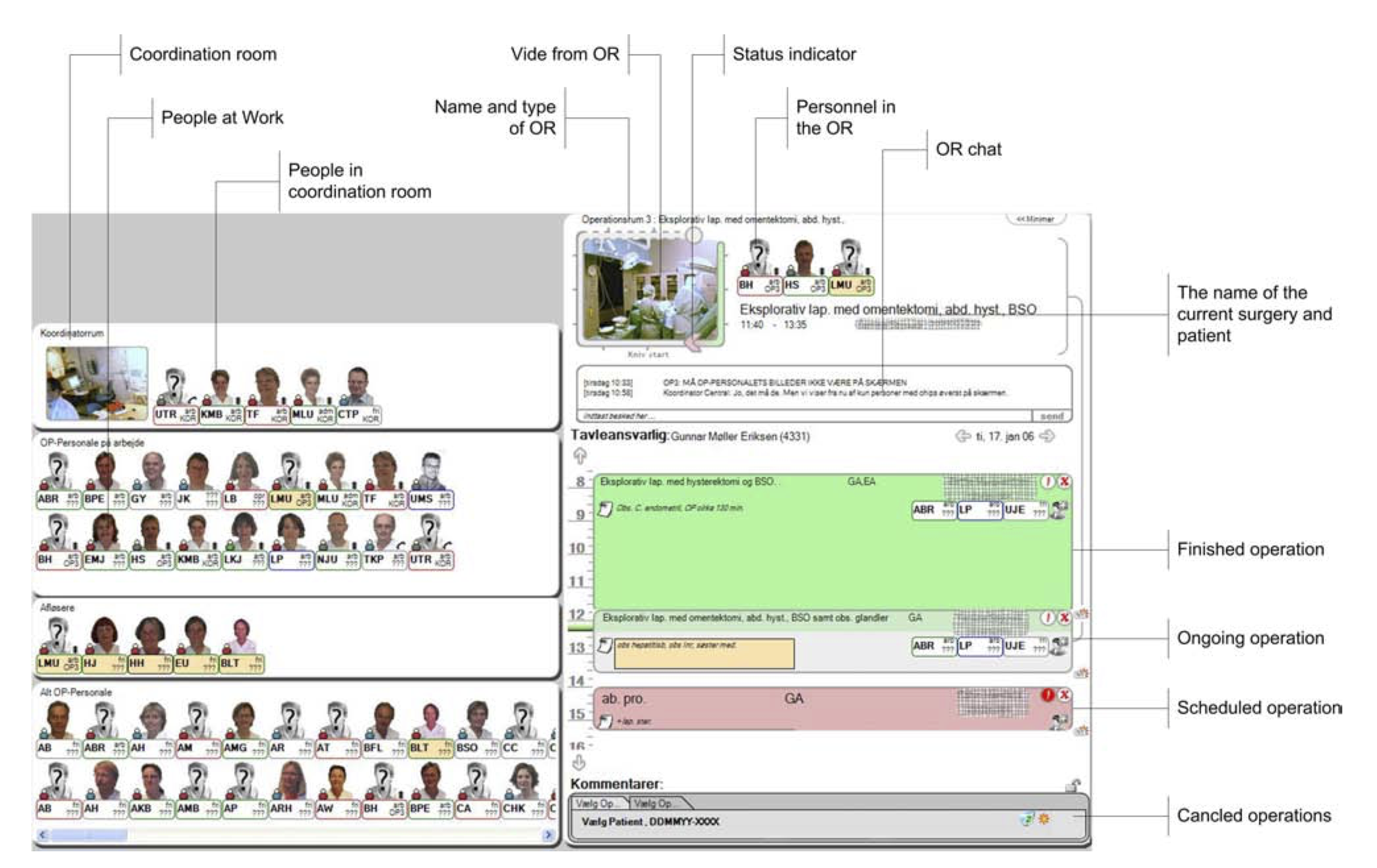
To assist clinicians in achieving an effective yet flexible real-time coordination, we designed, developed, and deployed AwareMedia in close collaboration with a local hospital. AwareMedica is a pervasive platform for supporting the close coordination and communication taking place in a hospital, with special focus on the work in an operating ward.
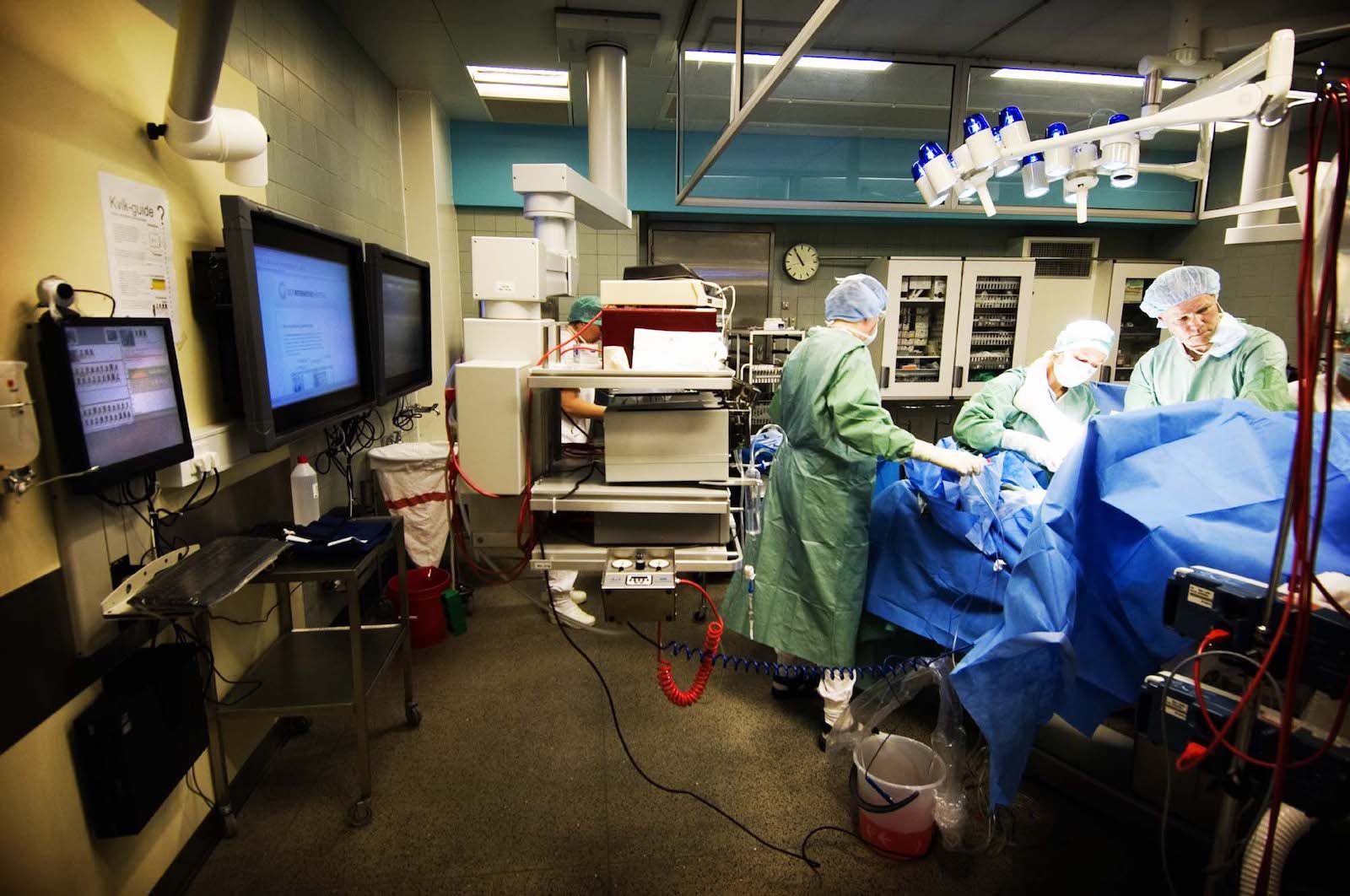
AwareMedia provides a design for how to support three types of awareness:
- social awareness where a person has an awareness about another person. This awareness may include knowing where he is, the kind of activity he is engaged in, or some self-reported status
- spatial awareness where a person maintains an awareness about a specific place and can e.g. monitor what is happening there
- temporal awareness which provides an awareness about past, present, and future activities that are significant to a person.
These three kinds of awareness are not comprehensive but the most important ones that we have observed in coordination in a hospital environment.
References
![[pdf]](https://www.bardram.net/wp-content/plugins/papercite/img/pdf.png)
[Bibtex]
@Article{jcscw2010:bardram,
author="Bardram, Jakob E. and Hansen, Thomas R.",
title="Context-Based Workplace Awareness",
journal="Computer Supported Cooperative Work (CSCW)",
year="2010",
month="Apr",
day="01",
volume="19",
number="2",
pages="105--138",
abstract="Maintaining an awareness of the working context of fellow co-workers is crucial to successful cooperation in a workplace. For mobile, non co-located workers, however, such workplace awareness is hard to maintain. This paper investigates how context-aware computing can be used to facilitate workplace awareness. In particular, we present the concept of Context-Based Workplace Awareness, which is derived from years of in-depth studies of hospital work and the design of computer supported cooperative work technologies to support the distributed collaboration and coordination of clinical work within large hospitals. This empirical background has revealed that an awareness especially of the social, spatial, temporal, and activity context plays a crucial role in the coordination of work in hospitals. The paper then presents and discusses technologies designed to support context-based workplace awareness, namely the AWARE architecture, and the AwarePhone and AwareMedia applications. Based on almost 2 year' deployment of the technologies in a large hospital, the paper discuss how the four dimension of context-based workplace awareness play out in the coordination of clinical work.",
issn="1573-7551",
doi="10.1007/s10606-010-9110-2",
url="https://doi.org/10.1007/s10606-010-9110-2"
}![[pdf]](https://www.bardram.net/wp-content/plugins/papercite/img/pdf.png)
[Bibtex]
@inproceedings{cscw2006:bardram,
Address = {New York, NY, USA},
Author = {Jakob E. Bardram and Thomas R. Hansen and Mads Soegaard},
Booktitle = {CSCW '06: Proceedings of the 2006 20th anniversary conference on Computer supported cooperative work},
Doi = {http://doi.acm.org/10.1145/1180875.1180892},
Isbn = {1-59593-249-6},
Location = {Banff, Alberta, Canada},
Pages = {109--118},
Pdf = {fp327.bardram.pdf},
Publisher = {ACM Press},
Tag = {aware,jcaf,conference,phc},
Title = {AwareMedia: a shared interactive display supporting social, temporal, and spatial awareness in surgery},
Url = {http://doi.acm.org/10.1145/1180875.1180892},
Year = {2006},
Bdsk-Url-1 = {http://doi.acm.org/10.1145/1180875.1180892}}![[pdf]](https://www.bardram.net/wp-content/plugins/papercite/img/pdf.png) J. E. Bardram, T. R. Hansen, and M. Soegaard, “Large Interactive Displays in Hospitals – Motivation, Examples, and Challenges,” in Proceedings of the CHI 2006 Workshop on `Information Visualization and Interaction Techniques for Collaboration Across Multiple Displays’, L. Terrenghi, R. May, and P. Baudisch, Eds., , 2006.
J. E. Bardram, T. R. Hansen, and M. Soegaard, “Large Interactive Displays in Hospitals – Motivation, Examples, and Challenges,” in Proceedings of the CHI 2006 Workshop on `Information Visualization and Interaction Techniques for Collaboration Across Multiple Displays’, L. Terrenghi, R. May, and P. Baudisch, Eds., , 2006. [Bibtex]
@incollection{chi2006:awaremedia,
Author = {Jakob E. Bardram and Thomas R. Hansen and Mads Soegaard},
Booktitle = {Proceedings of the CHI 2006 Workshop on `Information Visualization and Interaction Techniques for Collaboration Across Multiple Displays'},
Editor = {Lucia Terrenghi and Richard May and Patrick Baudisch},
Pdf = {awaremedia.chi2006.pdf},
Tag = {aware,workshop},
Title = {{Large Interactive Displays in Hospitals - Motivation, Examples, and Challenges}},
Url = {http://nvac.pnl.gov/ivitcmd_chi06/},
Year = {2006},
Bdsk-Url-1 = {http://nvac.pnl.gov/ivitcmd_chi06/}}![[pdf]](https://www.bardram.net/wp-content/plugins/papercite/img/pdf.png) J. E. Bardram and T. R. Hansen, “The AWARE architecture: supporting context-mediated social awareness in mobile cooperation,” in Proceedings of the 2004 ACM conference on Computer supported cooperative work, 2004, p. 192–201.
J. E. Bardram and T. R. Hansen, “The AWARE architecture: supporting context-mediated social awareness in mobile cooperation,” in Proceedings of the 2004 ACM conference on Computer supported cooperative work, 2004, p. 192–201. [Bibtex]
@inproceedings{cscw2004:bardram,
Author = {Jakob E. Bardram and Thomas R. Hansen},
Booktitle = {Proceedings of the 2004 ACM conference on Computer supported cooperative work},
Isbn = {1-58113-810-5},
Location = {Chicago, Illinois, USA},
Pages = {192--201},
Publisher = {ACM Press},
Tag = {aware,jcaf,conference},
Title = {{The AWARE architecture: supporting context-mediated social awareness in mobile cooperation}},
Url = {http://doi.acm.org/10.1145/1031607.1031639},
Year = {2004},
Bdsk-Url-1 = {http://doi.acm.org/10.1145/1031607.1031639}}![[pdf]](https://www.bardram.net/wp-content/plugins/papercite/img/pdf.png) J. E. Bardram, “The Java Context Awareness Framework (JCAF) – A Service Infrastructure and Programming Framework for Context-Aware Applications,” in Proceedings of the 3rd International Conference on Pervasive Computing (Pervasive 2005), Munich, Germany, 2005, p. 98–115.
J. E. Bardram, “The Java Context Awareness Framework (JCAF) – A Service Infrastructure and Programming Framework for Context-Aware Applications,” in Proceedings of the 3rd International Conference on Pervasive Computing (Pervasive 2005), Munich, Germany, 2005, p. 98–115. [Bibtex]
@inproceedings{pervasive2005:bardram,
Address = {Munich, Germany},
Author = {Jakob E. Bardram},
Booktitle = {Proceedings of the 3rd International Conference on Pervasive Computing (Pervasive 2005)},
Editor = {Hans Gellersen and Roy Want and Albrecht Schmidt},
Month = May,
Pages = {98--115},
Pdf = {jcaf.pervasive.2005.printed.pdf},
Publisher = {Springer Verlag},
Series = {Lecture Notes in Computer Science},
Tag = {aware,jcaf,conference},
Title = {{The Java Context Awareness Framework (JCAF) - A Service Infrastructure and Programming Framework for Context-Aware Applications}},
Volume = 3468,
Year = 2005}
